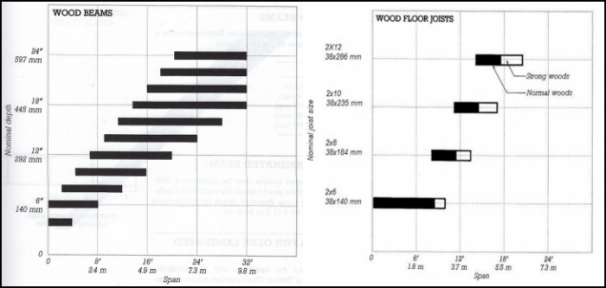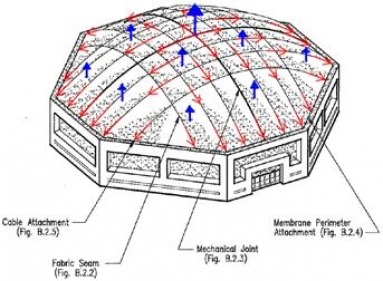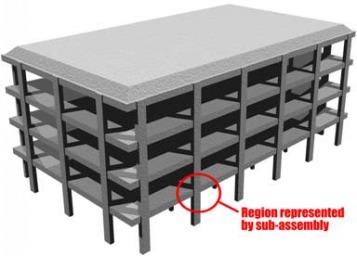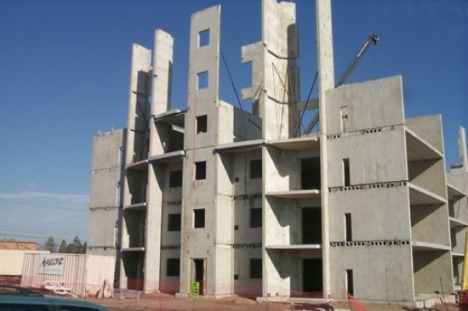1- Wood
The wooden framed structure uses a system of wooden pieces to create the structural support system of a building. In this case, wooden framed structures are usually composed of numerous wooden studs held together by a girder, both above and below the series of studs. This composition of wood pieces forms a wall that working together will form the structural skeleton of the building.
Strength Properties

This table shows the strength property of the three tree species that are most used in construction..
Typical Parameters

This graph shows the recommended range of spans that a variety of beams and joists should be used during construction.
Limitations
Moisture Content- For clear wood, mechanical property values continue to increase as wood dries below 10 to 15% moisture content. For lumber, mechanical property values reach a maximum at about 10 to 15% moisture content, then begin to decrease with decreasing moisture content below 10 to 15%. For either product, the effects of moisture content are considered to be reversible.
Load duration- Wood is known to carry substaintally greater maximum loads for short durations than for long durations of loading.
Size Limitation- The size of wood framing is limited in length because of the height of the trees. Because the strength values of the wood depend on its dimensions (height and width), the load which can be supported by the wood framing is also limited.
Load duration- Wood is known to carry substaintally greater maximum loads for short durations than for long durations of loading.
Size Limitation- The size of wood framing is limited in length because of the height of the trees. Because the strength values of the wood depend on its dimensions (height and width), the load which can be supported by the wood framing is also limited.
2- Pneumatic Structures
Pneumatic structure is a system that is supported by air and consists of a membrane, supporting cables, and an HVAC system. While dead load can sometimes be difficult for some strucutres, pneumatic structures often have one level which makes their load calculations relatively simple. Most of these structures have a load of about 1-2 PSF.

Advantages
- Considerably lower initial cost than conventional buildings
- Lower operating costs due to simplicity of design (wholly air-supported structures only)
- Easy and quick to set up, dismantle, and relocate (wholly air-supported structures only)
- Unobstructed open interior space, since there is no need for columns
- Able to cover almost any project
- Custom fabric colors and sizes, including translucent fabric, allowing natural sunlight in
Disadvantages - Continuous operation of fans to maintain pressure, often requiring redundancy or emergency power supply.
- Dome collapses when pressure lost or fabric compromised
- Cannot reach the insulation values of hard-walled structures, increasing heating/cooling costs
- Limited load-carrying capacity
- Conventional buildings have longer lifespan
3- Steel Frame System
Structural steel: This method produces such common elements as wide flange sections, channels, bars, and plates. This system is widely used in reality from single-story structures to the tallest buildings. In general, structural steel frame can support variety of cladding systems and most common use is with curtain walls of steel, aluminum, glass, masonry, and stone
Lightweight steel- this method is used in low-rise structures where the lightweight and ease of assembly of these elements are advantages. The most advantage of this system is its noncombustibility of steel which allows lightweight steel system to be used in building types where wood construction is not permitted.
Lightweight steel- this method is used in low-rise structures where the lightweight and ease of assembly of these elements are advantages. The most advantage of this system is its noncombustibility of steel which allows lightweight steel system to be used in building types where wood construction is not permitted.

Limitations
Uses:
- Weak in compression
- Corrosive
- Poor fire rating
- Meets the fatigue limitation and permanently deforms quicker
Uses:
- Office Buildings
- Hotels/Apartments
- Schools
- Bridges
- parking garages
- arenas
- hospitals
4- Concrete Frame System
Advantages- Precast prestressed concrete framing systems are characterized by reduced depths and deflections for spanning members, faster construction, and increased quality and durability of the concrete itself. The advantage is that the individual elements in the system may be removed or replaced easily.
Disadvantages- Precast concrete framing systems highly rely on shear walls or braced framing for resistance the lateral forces.
Disadvantages- Precast concrete framing systems highly rely on shear walls or braced framing for resistance the lateral forces.

Limitations:
- Weak in tension
- Environmental Issues
- Difficult to build taller buildings due to weight of concrete
- Weather conditions affect pouring: humidity, precipetation
Typical Span Distances:
- Concrete Slabs: 10 ft - 50 ft
- Concrete Beams: 15 ft - 65 ft
Parameters:- Density: 150 lb/ft3
- Young's Modulus: 4350 ksi
- Melting Point: N/A
- Tensile Strength: 5.8 ksi
- Compressive Strength: 50-60 ksi (Curing: 28 days)
- Poisson's Ratio: 0.1 - 0.2
- Coefficient of Thermal Expansion: 4 to 8 x 10^-6 /deg F
- Yield Strength: N/A
- Ultimate Strength: 0.45 ksi

Common Failure Modes of Steel reinforced Concrete:
Mechanical Failures
Carbonation
Chlorides
Alkali Silica Reaction
Sulfates
Mechanical Failures
Carbonation
Chlorides
Alkali Silica Reaction
Sulfates
